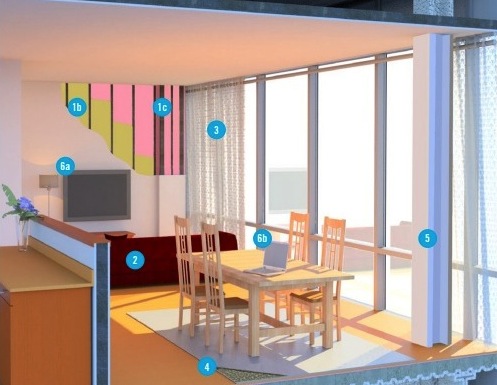Global architecture and design firm Perkins+Will has released new research in response to the need for architects and interior designers to develop a better understanding of flame retardants and their impact on health.
The white paper, “Healthy Environments: Strategies for Avoiding Flame Retardants in the Built Environment,” was developed by Perkins+Will’s Healthy Materials Group and Science Fellow Michel Dedeo. It identifies both new and existing opportunities to design healthier buildings without compromising fire safety or code compliance.
Flame retardants in the built environment are associated with a range of health impacts including cancer, endocrine disruption, and neurodevelopmental problems. Many flame retardants are persistent, bioaccumulative, and/or toxic, and their use in buildings is largely avoidable.
Perkins+Will’s white paper includes a list of 193 flame retardants, including 29 discovered in building and household products, 50 discovered in the indoor environment, and 33 discovered in human blood, milk, and tissues.
The research can help designers identify which products should be subjected to extra scrutiny during the design and construction process and provides options for less hazardous alternatives. The white paper also helps to identify gaps in current understanding of the sources and paths of chemical exposure.
“We want to bring awareness to this important issue impacting the health and wellbeing of building occupants,” said Perkins+Will’s Healthy Materials Leader Suzanne Drake. “The research we have conducted is a valuable resource for identifying healthy alternatives to flame retardant building materials.”
Related Stories
| Jun 2, 2014
Parking structures group launches LEED-type program for parking garages
The Green Parking Council, an affiliate of the International Parking Institute, has launched the Green Garage Certification program, the parking industry equivalent of LEED certification.
| May 29, 2014
7 cost-effective ways to make U.S. infrastructure more resilient
Moving critical elements to higher ground and designing for longer lifespans are just some of the ways cities and governments can make infrastructure more resilient to natural disasters and climate change, writes Richard Cavallaro, President of Skanska USA Civil.
| May 23, 2014
Top interior design trends: Gensler, HOK, FXFOWLE, Mancini Duffy weigh in
Tech-friendly furniture, “live walls,” sit-stand desks, and circadian lighting are among the emerging trends identified by leading interior designers.
| May 20, 2014
Kinetic Architecture: New book explores innovations in active façades
The book, co-authored by Arup's Russell Fortmeyer, illustrates the various ways architects, consultants, and engineers approach energy and comfort by manipulating air, water, and light through the layers of passive and active building envelope systems.
| May 19, 2014
What can architects learn from nature’s 3.8 billion years of experience?
In a new report, HOK and Biomimicry 3.8 partnered to study how lessons from the temperate broadleaf forest biome, which houses many of the world’s largest population centers, can inform the design of the built environment.
| May 13, 2014
19 industry groups team to promote resilient planning and building materials
The industry associations, with more than 700,000 members generating almost $1 trillion in GDP, have issued a joint statement on resilience, pushing design and building solutions for disaster mitigation.
| May 11, 2014
Final call for entries: 2014 Giants 300 survey
BD+C's 2014 Giants 300 survey forms are due Wednesday, May 21. Survey results will be published in our July 2014 issue. The annual Giants 300 Report ranks the top AEC firms in commercial construction, by revenue.
| Apr 29, 2014
USGBC launches real-time green building data dashboard
The online data visualization resource highlights green building data for each state and Washington, D.C.
| Apr 22, 2014
Bright and bustling: Grimshaw reveals plans for the Istanbul Grand Airport [slideshow]
In partnership with the Nordic Office of Architecture and Haptic Architects, Grimshaw Architects has revealed its plans for the terminal of what will be one of the world's busiest airports. The terminal is expected to serve 150 million passengers per year.
| Apr 9, 2014
Steel decks: 11 tips for their proper use | BD+C
Building Teams have been using steel decks with proven success for 75 years. Building Design+Construction consulted with technical experts from the Steel Deck Institute and the deck manufacturing industry for their advice on how best to use steel decking.

















